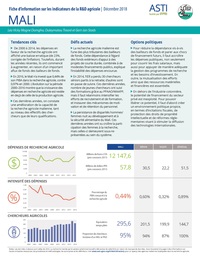Authors:
Léa Vicky Magne Domgho, Ouleymatou Traoré et Gert-Jan Stads
Year:
2018
Publisher
International Food Policy Research Institute and Institut d’Économie Rurale.
Back to:
Key trends
- Agricultural research spending followed an erratic downward path during 2000–2014, dropping by nearly a quarter (in inflation-adjusted terms). In more recent years, however, spending levels have started to increase again due to an important influx of donor funding.
- Agricultural research spending has not been able to keep pace with growth in agricultural production: as of 2016, Mali invested just 0.44 percent of its AgGDP in agricultural research, down from 0.97 percent in 2000.
- Agricultural researcher numbers have steadily increased over the past decade, as have their qualification levels.
Current challenges
- Agricultural research in Mali is among the most donor-dependent in Africa. Strong reliance on short-term projects funded by donors and development banks, combined with modest levels of public funding, have driven significant fluctuations in agricultural research spending over time.
- In 2014, IER lost 30 experienced researchers to retirement and many more departures are imminent. WAAPP has supported significant training of young researchers in recent years. However, more recruitment and training are needed, as are mechanisms to motivate and maintain staff over time.
- Persistent gender disparities continue to challenge Mali’s development and food and nutritional security. Women remain grossly underrepresented in Mali’s agricultural research system as well, despite increased involvement in research by female scientists in recent years.
Policy options
- To reduce the reliance on foreign donors and mitigate future funding shocks, increased government funding is needed, not only to cover the cost of salaries, but also to allow sufficient funding for the day-to-day running of research programs, as well as necessary investments in infrastructure.
- Creative mechanisms should also be explored to stimulate private-sector research funding beyond the cotton industry. Cultivating private funding involves providing a more enabling policy environment in terms of tax incentives, protection of intellectual property rights, and regulatory reforms to encourage the spill-in of international technologies.

